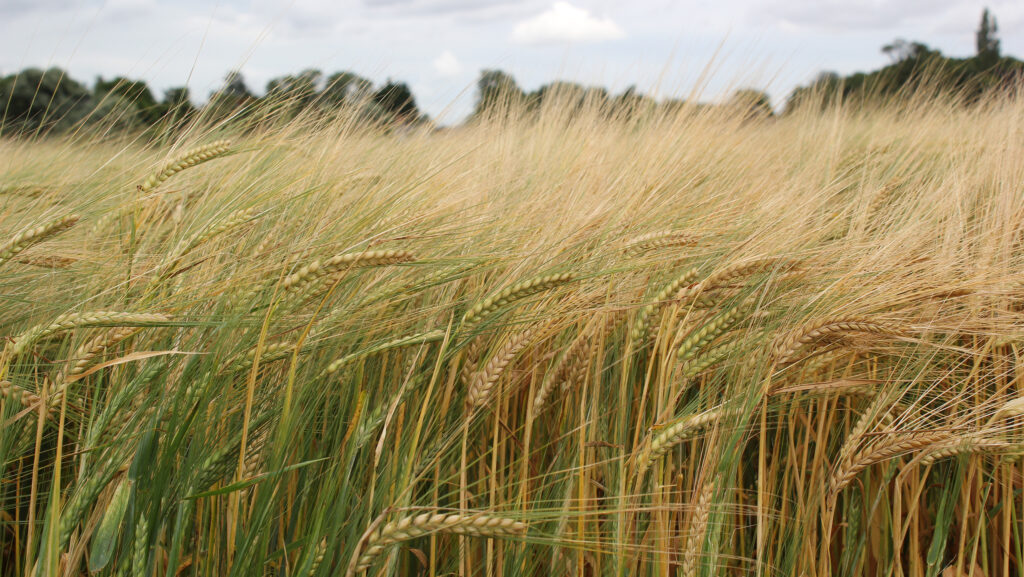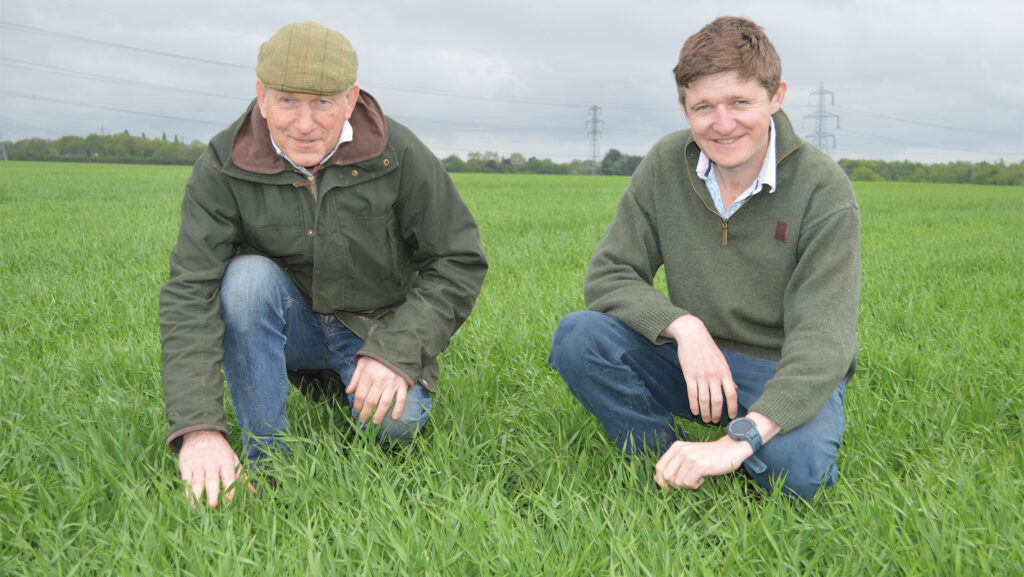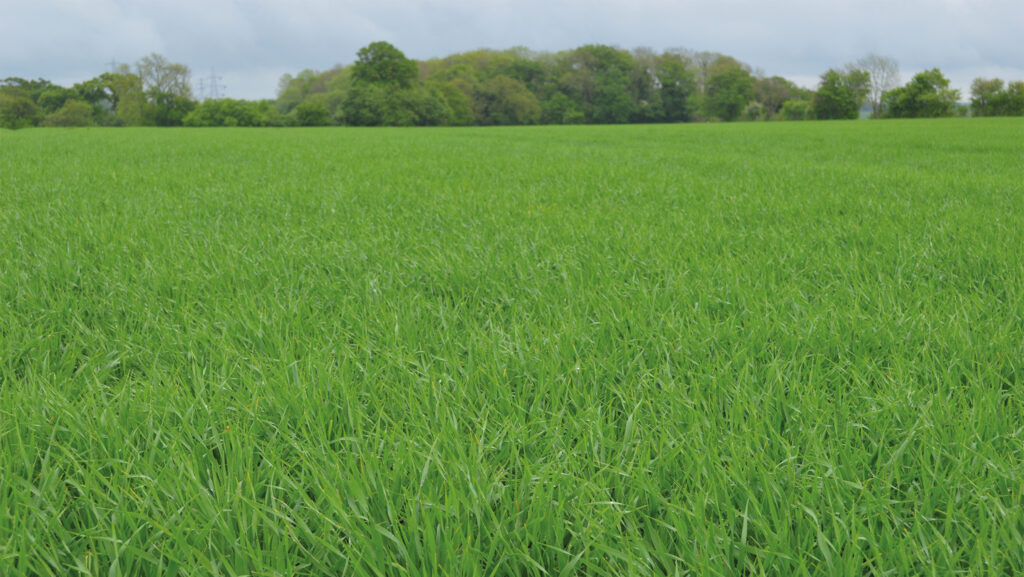Brewing barley gains ground in this spring’s sowings
 Skyway spring barley © Agrii
Skyway spring barley © Agrii Edward Watson turned to spring barley to try and beat blackgrass on his family’s heavy-land farm.
He is now growing a malting crop to rival the profit from his top-quality milling wheats.
Good yields, low inputs and a sizable price premium make the spring crop an attractive option for Greens Farm, located on the Hertfordshire/Essex border.
The family farm is run by Edward, along with his father, Ian, and uncle, Michael.
See also: How a Lincs farm dries grain cheaply without fossil fuels

Edward Watson (right) and Michael Watson © David Jones
They chose the specialist brewing variety Skyway which gave him a £70-£80/t premium over feed barley last harvest.
It is now nationally the bestselling brewing malting spring barley variety, taking over from Planet.
“The spring barley Skyway is good for gross margins, good for blackgrass and relatively cheap to grow, while giving high yields,” he says.
Variable costs of seed, fertiliser and sprays at £350/ha for a 7t/ha-yielding spring barley crop are half those of a 9t/ha milling wheat crop.
The spring barley gross margin was nearly as good as milling wheat, with both within a £1,200-£1,500/ha range.
This season, nitrogen fertiliser rates are being trimmed to try and ensure malting quality.
On the farm’s fertile heavy land, spring barley follows milling winter wheat, which may leave some residual nitrogen.
Michael is impressed with the spring barley variety. It has good standing power, high specific weight and shows vigorous early growth, which helps smother young blackgrass.

Skyway spring barley in mid-May © David Jones
Double spring break
“A double spring break of spring barley, followed by either spring beans or spring linseed, has really helped control blackgrass on the farm,” says Michael.
Skyway, bred by Danish group Nordic Seed, is distributed by agronomy group Agrii.
It is now the second bestselling spring barley variety, behind dual-purpose variety Laureate, which can be grown for brewing or distilling.
The Watson family run 950ha of arable land at Furneux Pelham, some six miles north-west of Bishop’s Stortford.
They grow milling winter wheat, winter barley, spring beans and linseed, as well as spring barley on largely chalky boulder clay.
The move to spring barley in 2022 was largely to get on top of blackgrass as part of a two-year spring break, after two years of milling winter wheat.
The high-yielding variety Skyway was chosen as a feed barley in 2022, before it was fully approved by the maltsters.
In a very dry year, 47ha yielded 7.7t/ha, with 130kg/ha of nitrogen fertiliser applied.
The following year, they pushed the area up to 55ha, again grown primarily as a feed rather than a malting barley.
It yielded 6.9t/ha in a wet year, with 130kg/ha of nitrogen applied.
Both years showed yields above the farm’s budget of 6.5t/ha.
However, in spring 2023, the variety gained full approval by the maltsters for use in brewing, and the farm tested the grain nitrogen content at harvest.
It came in at 1.7%, well under the maximum standard for brewing at 1.85%.
The crop was sold through malting barley specialist grain trader Robin Appel at a price of nearly £250/t, or a £70-£80/t premium over feed barley.
Increased area
This prompted a move to increase the spring barley area further to 100ha this year.
They also cut back on nitrogen to 110kg/ha to try an ensure a malting premium.
The land destined for the variety in 2024 was min-tilled with a tined cultivator in the autumn of 2023.
This was to help incorporate chopped wheat straw and get some air into the heavy clay soils.
The crop was sown in the second half of March without any further soil cultivation disturbance.
The spring barley was drilled with the farm’s Amazone Cayena and Horsch Sprinter tined drills at 190kg/ha to give 380 seeds/sq m.
Half of the 110kg/ha of nitrogen was applied in the seed-bed and the final half at the three-leaf stage.
Sulphur was also applied to the seed-bed in the form of polysulphate at 100kg/ha of product.
The crop is set to receive two herbicides – tri-allate (Avadex) residual granules for blackgrass and a broad-leaved weedkiller.
A plant growth regulator will also be used, and two fungicides with a SDHI-azole mix at T1 and SDHI-strobilurin combination at T2.
Last summer was the final cereal crop to harvest in mid-August, as the family prioritised the milling wheats Skyfall and Crusoe to try and maintain their Hagberg quality.
“We have been very pleased with Skyway and, although some of the crop started to lean over at harvest, it held onto a good specific weight,” says Michael.
Number one brewing barley
Skyway is starting to take over in popularity from the older variety Planet as the top brewing specialist spring barley variety, due largely to its higher yield.
It is the top-yielding, malting-approved spring barley variety on the current AHDB Recommended List, yielding 5% more than of Planet and 1% ahead of dual-purpose brewing and distilling variety Laureate.
Crop consultant Niab’s Clare Leaman, cereals variety specialist, says Skyway had a 10% share of the spring barley seed market in 2023, just ahead of Planet at 9%.
However, she expects Skyway to be pulling away from Planet in the current season.
Dual-purpose varieties
For growers on light specialist malting barley land – such as the chalklands of southern England, north Norfolk and Scotland – dual-purpose varieties such as Laureate and Diablo tend to be first choices.
They can be aimed at the distilling market, which looks for a grain nitrogen of below 1.65%, and if only a touch above, they can still be acceptable for brewing at below 1.85%.
In 2023, Laureate had a 49% share of the spring barley seed market and Diablo 9%.
Grain firm Robin Appel’s trading director, Jonathan Arnold, says Skyway is gaining market share in the higher nitrogen malting barley market, largely due to its yield.
“We see Skyway as a Planet replacement for the growers who are away from the traditional light malting barley soils, where there is an opportunity for this type of slightly higher nitrogen type of barley,” he says.
Increased demand
Agronomy group Frontier’s seed business development manager, Jim Knightbraid, agrees, and says he has seen a pick-up in demand for the variety.
“Skyway looks a logical step up from Planet, and we have seen a strong interest in Skyway where there is a good demand from the brewing market,” he adds.
Experts say yield and the maltsters’ approval often separates many of these spring barley varieties, with agronomic features broadly similar for all four leading varieties – Laureate, Skyway, Planet and Diablo.
All four show good resistance to mildew, are moderate to good against rhynchosporium, and moderate to poor against brown rust.
All have fairly stiff straw, good resistance to brackling, and similar maturity – apart from Diablo, which is a touch later.
The UK maltsters expect to buy 1.9-2m tonnes of malting barley from the 2024 harvest.
Their latest figures for seasonal use from the 2023 English and Scottish harvests show that Laureate accounted for almost 53% of all spring barley purchases.
This was followed by Planet on 10.4% and Diablo on 9.5%, with Skyway not categorised.
Spring barley accounted for nearly 86% of all maltsters’ purchases from the 2023 harvest, with the remainder from winter barley varieties such as Craft, Flagon and Maris Otter.
Leading spring malting barley varieties |
||||
| Variety | Skyway | Planet | Laureate | Diablo |
| Fungicide-treated yield | 102% | 97% | 101% | 99% |
| Untreated fungicide yield | 91 | 87 | 92 | 88 |
| Disease resistance | ||||
| Mildew | 8 | 8 | 9 | 8 |
| Rhynchosporium | 7 | 6 | 7 | 6 |
| Brown rust | 4 | 4 | 5 | 5 |
| Other features | ||||
| Brackling | 8 | 8 | 8 | 8 |
| Resistance to lodging without plant growth regulator | 7 | 7 | 6 | 7 |
| Ripening versus Planet (days) | 0 | 0 | +1 | +3 |
| Specific weight (kg/hl) | 69.3 | 68.7 | 67.2 | 67.7 |
| Grain nitrogen (%) | 1.52 | 1.52 | 1.49 | 1.50 |
| Note: Agronomy measure on a 1-9 scale, where a higher figure indicates a variety shows the characteristic to a higher degree | ||||

